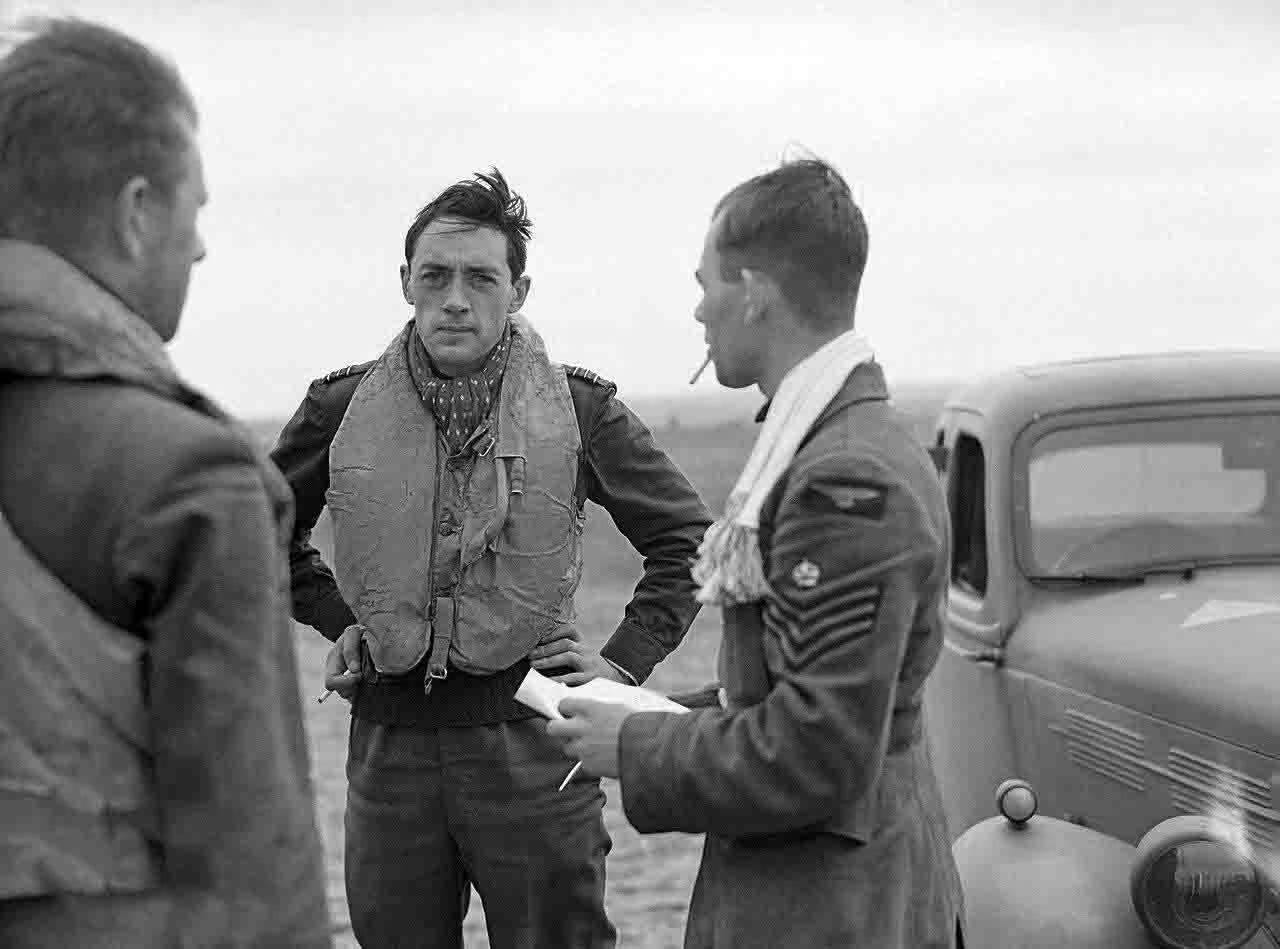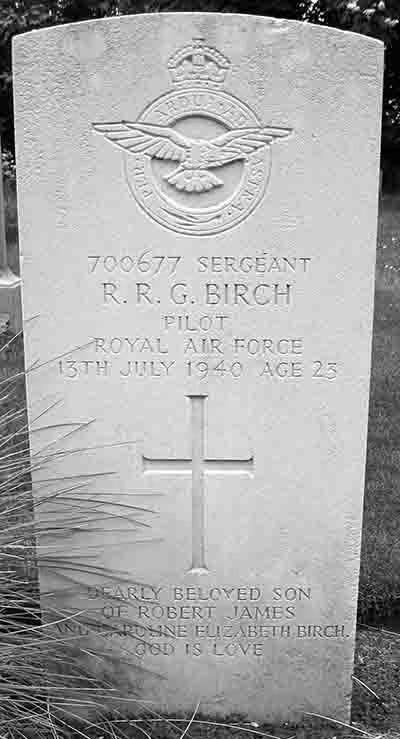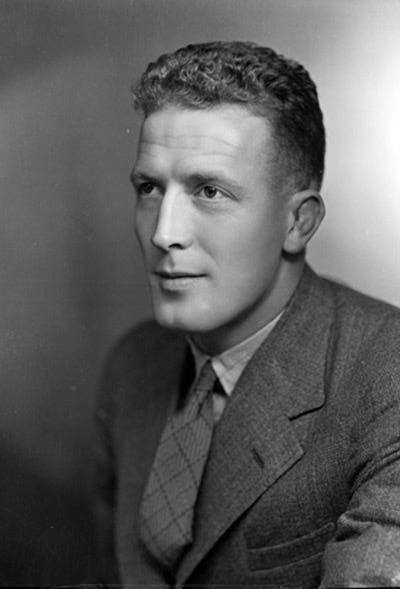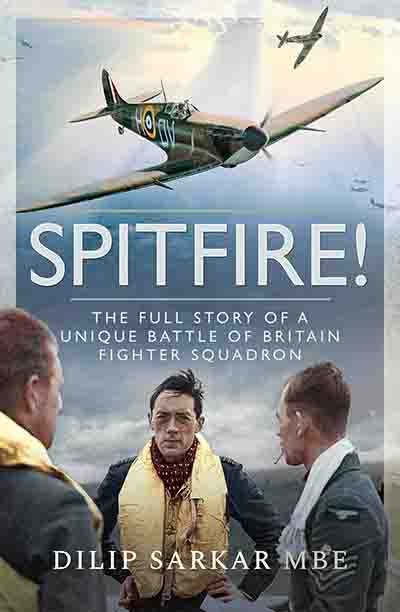'Spitfire!'
13th July 1940: The fate of three pilots who feature in 'The Full Story of a Unique Battle of Britain Fighter Squadron'

Dilip Sarkar1 has written extensively about the Battle of Britain, with much of his work based on his contacts (and long-standing relationships) with veterans who fought in the battle. He has covered many different aspects of the air war of 1940 and his thorough research has uncovered some new perspectives.
In Spitfire!: The Full Story of a Unique Battle of Britain Fighter Squadron, Sarkar turned his attention to No. 19 Squadron. This is the revealing story of how an RAF fighter squadron went to war, based on many first-hand accounts from the men who were there, together with many contemporary photographs. A comprehensive history of how they got to grips with flying a new aircraft, pioneered the experimental cannon-armed Spitfires, and fought a desperate battle over many months. Not all of them survived.
The following three short excerpts focus on three different individuals who flew with No. 19 Squadron.
The first is Douglas Bader, now a well-known figure. In 1940 he was well known within the RAF. In 1931, he had lost his legs in an accident during an flying display and had left the RAF because they considered him unfit to fly with such serious disabilities. But with the advent of war, he lobbied hard to be re-admitted. So he returned to flying duties with two tin legs:
Given the substantial technical differences between the biplanes he had flown previously and the new monoplane fighters, Flying Officer Bader’s Spitfire transition was not an entirely seamless process. His first Spitfire flight occurred on 12 February 1940. Beforehand, Bader sat in the cockpit of K9853, whilst
“a young pilot officer, with little experience, showed me the knobs. He omitted to tell me one important thing about the undercarriage operation which embarrassed me in due course, fortunately without damage.’
An unimpressed Pilot Officer Frank Brinsden, however, tells a somewhat different tale:
I feel free to elaborate on this comment as Douglas raised the matter and I was there. Any ‘young pilot officer with little experience’ on 19 Squadron assigned to brief Douglas Bader would actually have been flying Spitfires since October 1938. By early February 1940, when Bader came on the scene, that pilot officer would have been qualified to fly operationally by both day and night. Is such a pilot officer therefore likely to have omitted from the briefing the rather important matter of raising the undercarriage? In any case the crew room had an ample supply of Pilot’s Handling Notes and anyone who embarked upon his first solo in such a (for its time) radical aircraft without fully understanding its controls was a complete bloody fool! It must be remembered that the biplanes with which Bader had previously been familiar had a fixed undercarriage. Although he had flown a handful of hours in a Hurricane, retractable undercarts remained relatively new to him.
Pilot Officer Michael Lyne:
By March 1940 the weather was better but we now Officer Douglas Bader to contend with. He was very brave and determined but having a hard time getting to grips with the Spitfire, a far more advanced machine than he had flown previously. He particularly experienced problems in cloud. More than once my friend Watson and I were lent to Bader as a formation by the CO, but emerged from cloud faithfully following our leader only to find ourselves in a steep diving turn!
Bader, the RAF legend, was not only having ‘a hard time’ with the Spitfire but also fitting into 19 Squadron as a comparatively junior officer, his rank not commensurate with either his age or contemporaries. Douglas was nearly thirty, a flying officer, whilst his Cranwell chums were largely all squadron leaders. So here was Flying Officer Douglas Bader outranked by much younger men, mostly SSC officers, and serving in a squadron commanded by his best friend and an exact contemporary. Bader’s antipathy is reflected in Paul Brickhill’s best-selling 1952 account of his life, Reach for the Sky, referring to a flight with Brian, his flight commander, described as ‘an unblooded veteran of twenty-five’.

Brian was actually only twenty-three but had been a fighter pilot since 1936, had many flying hours on Hurricanes and Spitfires, and enjoyed an ‘Exceptional’ rating of his ability as a fighter pilot. Whilst on finals during this particular sortie, Bader’s Spitfire hit and removed the roof of Duxford’s cricket pavilion., removing his tail wheel in the process.
According to Brickhill, the section leader, whom he does not identify by name, but was Flight Lieutenant Lane:
came across laughing and said “I’m awfully sorry, ole boy. Most extraordinary thing - d’ya know not long ago I landed a chap in a tree just the same way” He never forgot the blunt details which Bader told him about his character in the next five minutes.
This, like the story alleging that Brinsden failed to explain the Spitfire’s undercarriage controls, is completely untrue. Brian Lane was a quiet intellectual, a highly experienced and competent fighter pilot and leader, not a reckless flippant. This was actually only Bader’s second flight in a Spitfire. On the first he had ‘embarrassed’ himself by forgetting to lower the undercarriage. This latest accident was due entirely to his own inexperience on type and failing to cope with reduced visibility during landing caused by the Spitfire’s long nose.
Later, during a dummy interception of Wellington bombers, Bader hit a tree whilst low flying. Characteristically he blamed his leader, but Stephenson’s response was ‘Well, you’re the silly clot. It’s up to you to see where you are going. He can’t fly the aeroplane for you,’ suggesting that even his old friend was getting fed up with Bader’s lack of humility and inability to cope with actually being 19 Squadron’s most junior pilot.
As previously explained, German air attacks were expected to approach across the North Sea and comprise unescorted bombers. Consequently, the RAF tacticians devised ‘Fighting Area Attacks’ consisting of six set-piece attacks involving the whole squadron in sections of three. Indeed, owing to the high speeds now achieved by modern monoplanes, many believed that fighter-versus-fighter combat would no longer be an option due to the higher stresses and strains on both aircraft and pilots. Douglas Bader disagreed, and poured scorn on the RAF manual, arguing that once battle was joined, each pilot should attack independently as he saw fit, not be bound to an inflexible rehearsed attack that in reality would be impossible owing to evasive action and return fire. In this, he was entirely correct.
Bader held court, impressing his views on fighter tactics to all who would listen, and remonstrated with Stephenson regarding the formation attacks 19 Squadron trained on. Stephenson’s response was that he had no brief to deviate from the tactics stipulated by the Air Ministry, which relied upon teamwork and not independent action. This disagreement with Stephenson exasperated Bader.
By this time, the Spitfire’s original fixed pitch airscrew had been replaced by the two-pitch de Havilland propeller, another modification with which Flying Officer Bader was unfamiliar.
Pilot Officer Michael Lyne:
On 31 March 1940 Douglas was leading our section of three Spitfires on a convoy patrol. We went off downwind on the shortest run at Horsham. Douglas, however, forgot to put the airscrew into fine pitch for take-off and cartwheeled across the main road and into a ploughed field. Watson and I stuck with him until the last minute but then pulled up and away on emergency power. I remember only just clearing the hedge and seeing clods of earth flying high overhead from my leader’s Spitfire. Bader broke a pair of artificial legs in the accident, in fact, and had to send away for a new pair.
AC1 Fred Roberts:
A section of A Flight was taking off, led by Flying Officer Bader. We were watching, but what was happening? Bader didn’t seem to be rising to any height. One of the Flight Mechanics with us shouted ‘The silly bugger’s in coarse pitch! ’The Spitfire hit the stone wall bounding the airfield and made a belly landing on the other side. Today it would be classified as pilot error, but in those days, it was a bloody great gaffe In the pile-up Bader bent his metal legs badly. It could have been worse had he not had those legs!
Flight Sergeant George Unwin:
Sometime after Bader’s accident we were at Horsham and Bader persisted in filing his new pair of tin legs, to get them in perfect working order, and I remonstrated with him for scratching and scraping whilst I was trying to sleep. The Disney film Snow White and the Seven Dwarfs was very popular at that time and Bader replied ‘Oh shut up, Grumpy!’ From then on, that was my nickname!
The Spitfire concerned in Bader’s latest faux pas, K9858, was written off. It was an extremely stupid mistake on Bader’s part, earning a rebuke from Squadron Leader Stephenson and a ‘snarled response’ from the entirely blameworthy pilot who was becoming increasingly unhappy on 19 Squadron.
Bader told his CO, ‘Look, I don’t feel happy flying behind these younger chaps. I’m more experienced, older, although I’ve not got so many hours on Spitfires.’ The fact was Douglas was unhappy as part of a team, only happy if leading it. Fortunately for all involved the ‘associations of Cranwell’ once more came to his rescue.
The CO of another Duxford Spitfire squadron, 222, Squadron Leader H.W. ‘Tubby’ Mermagen, was another Cranwellian, and Bader knew that 222 needed a replacement flight commander. Bader asked Mermagen to approach the AOC, which, with Woodhall’s support, he did, and so it was that, on 16 April 1940, the newly promoted Flight Lieutenant Douglas Bader took command of 222 Squadron’s A Flight. Frank Brinsden summed up the feeling on 19 at Bader’s departure: ‘Although we all admired Douglas, I wasn’t the only pilot not sorry to see him go.’
…
Still the Squadron trained at night, even though, of course, the Spitfire had not been designed with night-flying or interceptions in mind. Such training and practice flights took place on 29 February 1940. Pilot Officer ‘Horrie’ Trenchard was flying that evening and night, having joined 19 Squadron four months previously.
With 776 flying hours recorded in his log book, Trenchard was not an inexperienced pilot; he also had 2.50 flying hours on Spitfires at night. Not having flown at night, however, since 21 December 1939, his flight commander, Flight Lieutenant Wilf Clouston of B Flight, ensured that, before doing so again, Trenchard first safely completed three ‘circuits and bumps’ at dusk. Duly satisfied, Clouston, who was officer in charge of night flying, authorised a longer flight at 2030 hours.
At that time, Trenchard took off, in Spitfire K9809, on what was ‘a moonless night with no horizon, clouds 8/1 Oth at 1,500 feet, visibility four to eight miles’ . Clouston watched Trenchard take off and climb to 400 feet. All being well, the flight commander turned his attention to another Spitfire in the Duxford circuit.
Then, catastrophe struck. Three officers and an airman at Duxford later gave evidence that:
they saw an aircraft flying straight and level from the direction of the aerodrome and at a height between 1,000 and 2,000 feet. It turned suddenly to the left and went into a straight dive which continued until the aircraft had disappeared; all four witnesses then heard a crash. Private Mortimer, 6th Suffolk Regiment, who was on guard duty in the vicinity of the aerodrome made a similar statement.
Pilot Officer Trenchard crashed at Whittlesford, a few miles from the aerodrome. Given that there was ‘no horizon’ , the most likely explanation for the cause of this sadly fatal crash was that having taken off, made his left-turn and accelerated out of the circuit, the pilot became disorientated, so, instead of continuing to fly straight and level, as he no doubt thought he was, the Spitfire was actually diving towards the ground. Sadly, such accidents were not uncommon, and a surprising number of aircrew lost their lives in similar circumstances during the war.
…
On 13 July 1940 Flight Lieutenant Brian Lane’s Red Section of A Flight patrolled uneventfully over Duxford between 1800 and 1820 hours.
Afterwards, a pair of A Flight Spitfires took off for dogfight practice, the veteran Flight Sergeant Harry Steere hoping to increase the experience of Sergeant Raymond Robert Grenville Birch. Born in Perth on 19 May 1917, Birch had trained at 5 FTS, passing out on 10 February 1940, and was ‘now on the point of becoming operational after sickness’.
Earlier that day, on another training flight, Birch had blacked out but recovered with sufficient height to retrieve the situation. On this occasion, ‘Sergeant Birch very unfortunately dived into the ground off a steep turn at about 2,000 feet.’ At 1900 hours, Spitfire R6688 crashed at Balsham, Linton, and burnt out, killing the pilot. Two days later a court of inquiry convened at Duxford, presided over by Squadron Leader Mermagen of 222 Squadron, to ‘allocate responsibility if any and make recommendations concerning the accident’.
The investigation concluded that ‘black-out was possibly the cause of this accident’; Wing Commander Woodhall considered that ‘owing to over-keenness, the dogfight was carried on at too low a height. It is recommended that a pilot who has been unfit should not in future be allowed to fly again until he has seen a Medical Board.’
Sergeant Birch subsequently joined Pilot Officer Trenchard in the churchyard of St Mary and Andrew at Whittlesford near Duxford.
The twenty-three-year old, who had 26.50 flying hours on Spitfires, was, in fact, a ‘gifted contributor to Punch, in which an obituary later appeared’ .
Sergeant Birch’s name, however, will not be found amongst those of the ‘Few’ , the RAF airmen who fought the Battle of Britain. Nothing was done, in fact, to define this qualification until 9 November 1960 when the Air Ministry decreed that, to qualify for the coveted Battle of Britain Clasp to the 1939-45 Star, ‘Any pilot or aircrew must have flown at least one operational sortie with any of the seventy-one accredited squadrons or flights between 0001 hrs on 10 July and 2359 hrs on 31 October 1940’. Consequently, not having made an operational flight, in spite of having lost his life between the relevant dates, the Squadron’s Punch cartoonist is not one of the fabled Few.

© Dilip Sarkar 2019, ' Spitfire!: The Full Story of a Unique Battle of Britain Fighter Squadron'. Reproduced courtesy of Pen & Sword Publishers Ltd.






